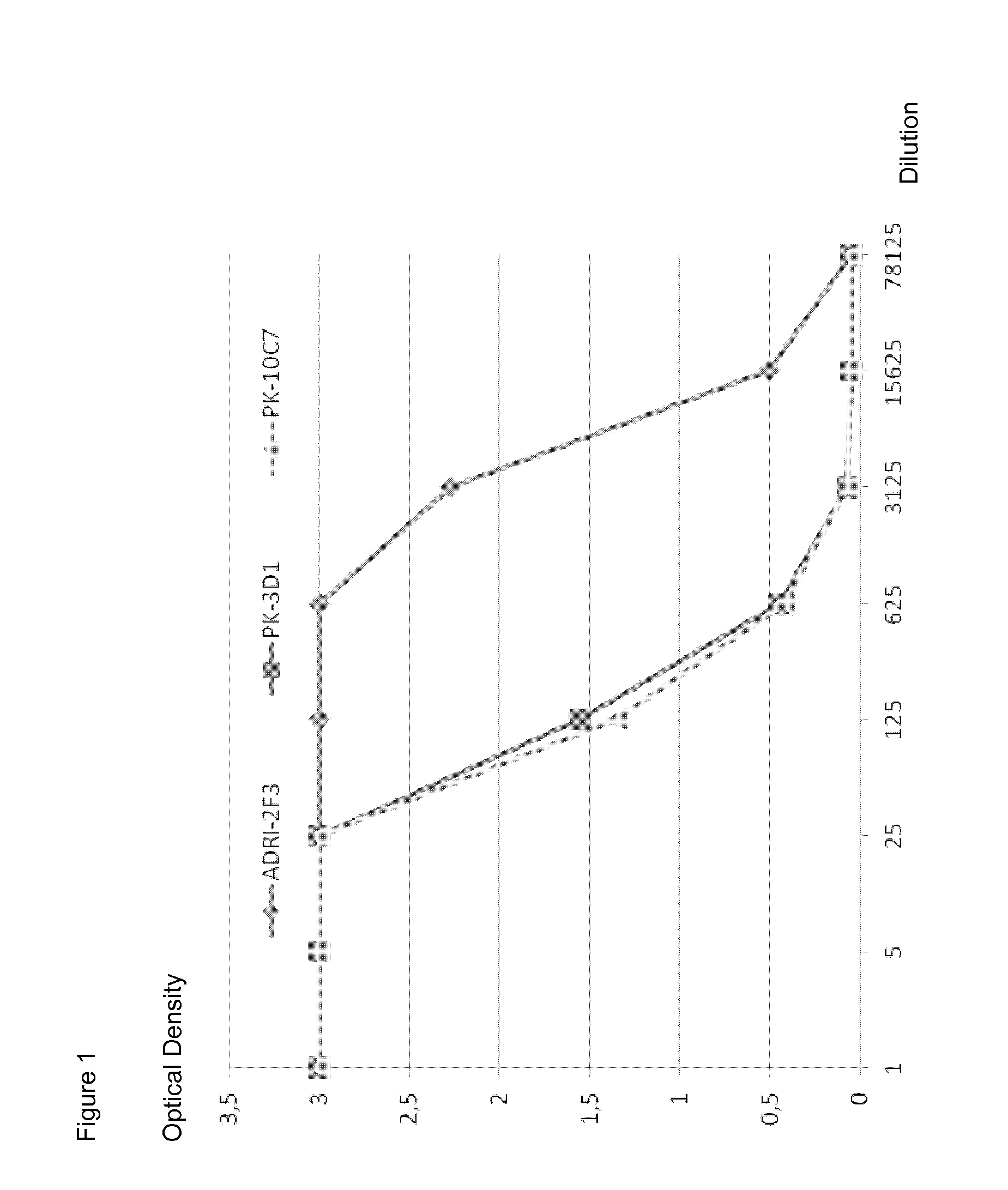Neutralizing human monoclonal antibodies against hepatitis b virus surface antigen
a technology of hepatitis b virus and surface antigen, which is applied in the field of medical treatment and prevention, can solve the problems of hbv posing a risk to healthcare workers exposed to accidental needle-stick injuries, needles, syringes and paraphernalia among intravenous drug users, and blood transfusions and blood products that have not been completely eliminated, so as to improve binding characteristics
- Summary
- Abstract
- Description
- Claims
- Application Information
AI Technical Summary
Benefits of technology
Problems solved by technology
Method used
Image
Examples
example 1
Isolation of HBsAg Specific B-Cell Clones
[0055]Peripheral blood mononuclear cells (PBMC) were obtained from a vaccinated healthy donor (ADR) and from a person convalescing from acute hepatitis B (PK). Both subjects showed high serum anti-HBsAg titers. PBMC were isolated by standard density gradient centrifugation and B cells negatively purified using a B cell isolation kit (B cell isolation kit II, code no 130-042-201 MACS—Miltenyi Biotec). B cells (10̂6 / ml, purity >95%) were then incubated with undiluted supernatant from the EBV-productive B95-8 marmoset cell line for 24 h at 37 degrees Celsius, washed and incubated in complete media consisting of RPMI-1640 supplemented with 10% fetal bovine serum (code SH30071.03 HyClone), 2.5 μg / ml CpG-2006 (Microsynt) and 10 ng / ml IL-2 (code no 202-IL R&D Systems) as described [8], with the modification that enrichment of CD27+ memory B cells was omitted. Approximately 3×10̂3 B cells in complete media were then seeded in each well of a 96-well r...
example 2
Determining B-Cell Clone Specificity
[0058]Specificity of the B-cell clones ADRI-2F3, PK-10C7 and PK-3D1 was determined by testing the supernatants by standard ELISA using a recombinant HBsAg preparation containing pre-S1, pre-S2 and S proteins. Monoclonal ADRI-2F3 secreted IgG1 lambda, whereas PK-10C7 and PK-3D1 secreted IgG1 kappa. All three mAbs showed strong binding to HBsAg in ELISA (FIG. 1). Binding of PK-10C7 and PK-3D1 was comparable, they showed clear binding at a dilution of 1 / 625. MAb ADRI-2F3 showed a clearly detectable binding to HBsAg at a dilution of 1 / 15625.
[0059]Binding to the common “a” determinant on the S polypeptide was determined by a competition ELISA using a murine mAb Hyb-824 (Cosmo Bio Co., LTD. Code no 2ZHB11 Cosmo Bio Co. LTD.) specific for the same region. Briefly, microtiter plates were coated with HBsAg at a concentration of 1 μg of 0.05M bicarbonate buffer (pH 9.6) per ml at 4° C. overnight. After saturation with 0.1 M PBS containing 2% bovine serum al...
example 3
HBV Neutralization Assay and mAb Neutralizing Activity
[0061]A neutralization assay was performed as previously described [13]. Briefly, primary Tupaia belangeri hepatocyte cultures were inoculated with purified human serum HBV at a ratio of 100 HBV genome / hepatocyte. To determine whether the uptake of HBV by primary Tupaia hepatocytes could be prevented by human anti-HBs mAbs, HBV was preincubated with three different human mAbs ADRI-2F3, PK-10C7, PK-3D1, at dilutions ranging from 1:10 to 1:10̂6.
[0062]The neutralization capability of the human anti-HBs mAbs was directly compared with the preS1-specific antibody MA18 / 7 which was previously shown to exhibit significant neutralizing activity in the Tupaia hepatocyte in vitro infection assay [13]. The read-out of successful HBV-infection of these cultures was newly produced HBsAg at a time point between 11 to 15 days after infection. Neutralization was considered effective if no viral protein production was detectable in the culture sup...
PUM
| Property | Measurement | Unit |
|---|---|---|
| concentrations | aaaaa | aaaaa |
| concentrations | aaaaa | aaaaa |
| concentrations | aaaaa | aaaaa |
Abstract
Description
Claims
Application Information
 Login to View More
Login to View More - R&D
- Intellectual Property
- Life Sciences
- Materials
- Tech Scout
- Unparalleled Data Quality
- Higher Quality Content
- 60% Fewer Hallucinations
Browse by: Latest US Patents, China's latest patents, Technical Efficacy Thesaurus, Application Domain, Technology Topic, Popular Technical Reports.
© 2025 PatSnap. All rights reserved.Legal|Privacy policy|Modern Slavery Act Transparency Statement|Sitemap|About US| Contact US: help@patsnap.com



